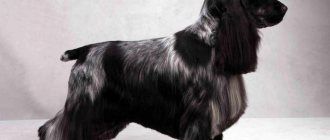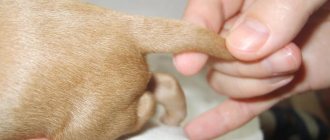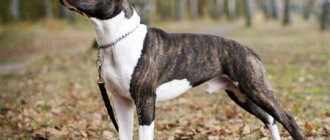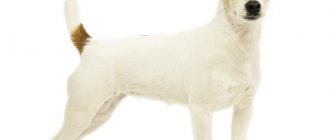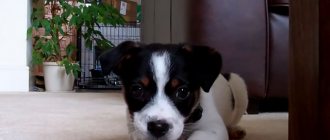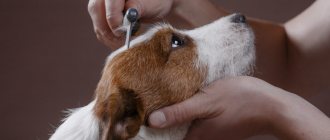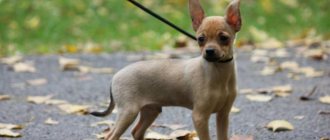After the release of the movie “The Mask” starring Jim Carrey and his four-legged companion named Moose, who played Milo, Jack Russell Terrier dogs gained unprecedented popularity. At the same time, the question of how necessary it is to dock the tail of such a dog has become particularly relevant.
The Jack Russell Terrier is a popular hunting breed of dog, but not only hunters like it. A lively mind, a mischievous character, a tireless temperament, together with a compact size, are ideal for any person who loves dogs and wants to share their home with them.
Due to such a wide range of Jack Russell Terrier lovers, opinions on the need for tail docking vary greatly. In this article we will try to highlight all the important points regarding this procedure.
Correct form
In the twentieth century, breeders began to pay special attention to the ears of Jack Russell Terriers. In order to prevent soil from getting into the dog’s ears during burrow hunting, they must be semi-erect, that is, slightly raised on the ear cartilage. When excited, the dog can turn them one hundred and eighty degrees.
In a state of calm, the pet's ears are in their normal position - they hang straight forward and fit tightly to the head, and their ends point straight down. Each dog's ear has only one fold - a fold line, which should not be lower than the level of the head.
Postoperative period
Typically, tail docking is easy and without complications. Already on the second day after the procedure, the puppy is cheerful and active again. Adult dogs may become restless by licking the amputation site. But this does not in any way affect their usual daily schedule. There is no need to change the diet; the wound is a minor injury that heals quickly in dogs.
However, there is a risk of encountering some complications:
- Bleeding. The older the dog, the higher the risk. If the wound bleeds, it must be treated with streptocide or a 5% alcohol solution of iodine. It is also advisable to bandage the tip of the tail for 12-24 hours. An additional protection is provided by a collar that will prevent licking and removal of the medicine.
- Inflammation of the sutures. Occurs when sterility measures are not observed during cupping, sutures come apart, also when the dog’s immunity is low or the presence of subclinical infectious diseases. You can treat the inflammation area with iodine, but it is better to entrust the treatment to a specialist.
If complications arise, the surest way out is to consult a veterinarian. A specialist will always be able to determine the treatment method more accurately and correctly.
Can a dog change as it ages?
If we talk about external changes in Jack Russells with age, then there are practically none . If you compare a teenage puppy and an adult dog of this breed, the difference is barely noticeable; the height changes somewhat upward.
But there may be changes in character, but most often this is due to the owner’s behavior towards the pet.
If an animal is treated like a child, then it may begin to do dirty tricks for fun, knowing that nothing will happen for it. The complete absence of any training gives the same effect.
Representatives of this breed need to be carefully handled.
Cruel treatment of a dog can make it aggressive and this is typical not only for Jack Russells, but also for any other breeds.
Very rarely, a surge of aggression can occur for no apparent reason; this most often happens to males aged 5-7 years and goes away on its own.
Preparing a dog for docking
This is a simple procedure. But for it to pass without complications, the dog needs to be prepared:
Important! A starvation diet helps prevent complications that may arise while the animal is under general anesthesia.
Methods for correcting ear setness
There are two methods of ear placement: mechanical and surgical. The latter is used exclusively in hopeless advanced cases. But the first method is painless for the pet and effective if you don’t wait too long. So called ear gluing can be done in different ways.
If the Jack Russell Terrier's ears point up, this needs to be corrected. Ideally, they should form a drooping "V" shape, have a sharp tip, and hang down the sides of the skull.
To do this, breeders perform the following steps:
- First, the fold line is conditionally determined. To do this, take the puppy's ear by the tip and bring it closer to the outer corner of the eye. This way you can see the correct shape you need to strive for.
- A patch is glued to the outside of the ear (parallel to the fold line) with a margin of 1-2 cm from the edge.
- Repeat the procedure on the inside in the same way.
- Along the edges of the ear, the patch is carefully cut off.
- To make it heavier, several more are applied on top of the first layer of plaster. It is important to ensure that you do not break the conditional fold line.
- Between the layers, you can place a coin on the outside of the ear, also wrapping it tightly with a band-aid (so that the glue does not remain on the skin).
At first, the dog may feel anxious as it tries to get rid of the bandage. Calm your pet, distract his attention until he gets used to the innovation. After 1-2 months, the ears should be in the correct shape.
This method is similar to the previous one with the difference that the ear is folded not only across, but also lengthwise. This creates two creases at once. The horizontal one should continue the line of the skull, and the vertical one should reach the lower edge of the ear.
The patch is glued around the entire ear in several layers. In this case, it is not advisable to place a coin. After 3 days, remove the bandage and examine the result. If after a day or two the ears do not rise, everything is fine. Otherwise, repeat the bandage again, but for 5 days. And so on until complete victory.
This method is relevant if your pet has irregular creases in the fold line. In this case, you need to glue it like this:
- Lift your dog's ear by pulling the tip upward.
- On the inside, stick the patch in several layers, but this time “to the length” of the shell. From base to tip.
- As in the first method, define a conditional fold line.
- Adjust your ear according to it, make a fold and fix it with your fingers for 15 minutes.
- Once formed, the patch will force the ear to remain in the correct position.
Basics of the procedure
There are two ways to install ears: surgical and mechanical. Surgical intervention using injections is necessary only in emergency, advanced cases. The second method will not bring any pain to the Jack Russell Terrier.
In order for your pet's ear placement to be successful, you first need to massage the ear cartilages along their fold line for several days. The massage must be thorough so that the cartilage acquires elasticity. Procedures must be carried out as often as possible - as many times a day as you can.
When you understand by palpation that the ear cartilages have softened, you can begin to glue them.
To do everything properly, prepare the following items in advance:
- adhesive medical plaster two to three centimeters wide;
- sharp scissors;
- weight - a coin or something similar.
It is worth noting that the Jack Russell Terrier is a very active dog, so it will be better if one of the family members helps you. He will be able to hold your pet while you glue the ears.
First option
This method is suitable for a dog whose ears are like a shepherd's.
First of all, you need to bend your pet's ear so that its tip points straight down. It should be level with the outer corner of the Jack Russell Terrier's eye. In this position, the fold line you need will appear.
Now cut a piece of tape slightly larger than the width of your dog's ear. You need to glue the patch on the outside, focusing on the fold line, parallel to it, but slightly lower. Don't forget to straighten the ear well, otherwise wrinkles will form under the patch.
Lift the Jack Russell Terrier's ear and repeat the same steps on the inside. Since one layer will not be enough to make it heavier, you will have to glue a sufficient number of layers of plaster - about three or four. Use a five-ruble coin as an additional weight, gluing it between the layers.
During the procedure, carefully ensure that the fold line remains the same and there are no folds. When finished, be sure to trim off the excess patch, otherwise your pet will be able to pull off the structure.
Second option
This method will help you get rid of irregular bends on the ears of your Jack Russell Terrier.
First of all, you need to lift your pet's ear by its tip so that it takes a standing position. From the beginning of the ear to the end, you need to glue several layers of adhesive on its inside. This way, the dog's ear will be fixed in a standing position.
Now we determine the correct fold line, as we did in the first example. Now you need to keep the Jack Russell Terrier's ear in this position for about fifteen minutes. As a result, it should remain in the correct state.
If, after you release your dog's ear, it becomes erect, then you have applied too many layers of tape. We'll have to remove the excess.
Third option
The Jack Russell Terrier will have to wear any of the designs until his ears take the required shape.
Remember to take a three-day break every seven days. If you do not remove the patch, diaper rash will appear on the skin, which will lead to inflammation. To prevent irritation, you can place a piece of medical bandage under the patch. If trouble does occur, wipe the affected area with salicylic alcohol. It will prevent the entry of various infections.
If your pet does not want to put up with your actions and constantly rips off the structure, you will have to use an enhanced method of ear placement.
First of all, we glue the patch along the inside of each dog’s ear, with a margin of two centimeters.
Now your assistant should bend the Jack Russell Terrier's ears correctly. And you need to glue the patch around the dog’s head so that the ears are fixed in the desired position - across the forehead, securing it under the neck. The tips of both ears should be supported by a supply of tape.
Be patient, distract your pet from the structure with active play with his favorite toys, and all your efforts will be rewarded with the correct positioning of your dog’s ears.
Are there any contraindications?
There is no reason not to dock a Jack Russell's tail. But if the dog feels unwell, it is better to reschedule the operation. It is recommended to postpone the procedure when:
- the dog is drowsy, lethargic and lacks appetite;
- puffiness or swelling appears on the body;
- there is atypical discharge from the mucous membranes of the nose or eyes.
The only contraindication to docking is the age of the animal. The operation should not be performed on old dogs. The subcaudal artery, through which blood flows to the tip of the tail, is quite large. The older the dog, the more effort it will take to sew it up. And post-traumatic swelling increases the already strong tissue tension.
As a result, the risk of suture dehiscence and subsequent bleeding increases.
Characteristics
A lively, agile and active terrier with a penetrating, intelligent look.
A lively, agile and active terrier with a penetrating, intelligent look. These are the three main components of its charm and overall appeal. Insight and intelligence are an integral feature of all terriers, especially the Jack Russell Terrier. Its character can be judged by the expression of its eyes, the set of its ears and its raised tail. However, a hyperactive dog is in no way superior to a dog that is calm, sedate and confident in its environment, treating others as equals. People are often mistaken in thinking that the better of the two terriers is the restless, galloping dog. A dog that is unreasonable in its actions will be of little use in the field, since it distracts the rest of the pack.
How the whole process works
There are two methods for shortening the tail:
- cutting off;
- using compression.
Surgical method
In the first method, the tail part is separated with surgical scissors. The procedure takes no more than half an hour. This method is considered less humane, but safer. At a young puppy's age, it is performed without anesthesia. The technique is as follows:
- First, the specialist determines the cutting location. The fur in the amputation area is shaved clean at a distance of 2 cm on each side of the cut line.
- The skin in the prepared area is thoroughly disinfected.
- The pet is then securely fixed in a prone position. The tail at the base is tied with a bandage or thread.
- The doctor pulls the skin of the tail towards its base, creating a small fold.
- Then pruning is carried out.
- The skin fold diverges, closing the wound. In the case of an adult dog (over 6 months), 1-3 sutures are placed along the edge of the cutting line.
- The rehabilitation period after surgical reduction lasts about two weeks.
For an adult dog, the procedure is similar, but anesthesia will be required.
Animals older than 3 weeks are given local anesthesia. In the case of an older dog, general anesthesia will be used. Typically, veterinarians use inhaled alcohol-chloroform-ether anesthesia in combination with a neuroplegic (Rompun) and atropine sulfate.
Without surgery
This method is considered humane, since the tail is amputated without surgery. It is simply pulled along the cutting line with a tight elastic band for 2-7 days. Due to the lack of blood supply, the atrophied area disappears.
However, there is a high risk that when the tissue dies, an infection may enter the puppy’s blood. The result may be sepsis, suppuration and inflammation. Only after being recently born can a puppy die. When choosing an amputation method, carefully weigh the pros and cons.
At home
To carry out this important procedure, of course, it is better to involve an experienced veterinarian or breeder. But you can do cupping at home. For the first case, it is advisable to ask for help from a specialist, carefully observing and assisting at every stage.
Before the procedure, isolate the mother dog in a separate room so that she does not interfere with the operation. Prepare for cupping:
- sterile scissors;
- brilliant green, alcohol;
- sterile disposable diaper;
- waste bowl.
Also clean your hands and work surface.
Take puppies one at a time for the procedure. Let the rest wait in line in the “nest” with the bitch. This minimizes stress for both the babies and the mother.
The process is carried out in the following sequence:
- Take the puppy and place his tail to the one who docks the tail.
- The assistant must hold the dog so that the limbs and body are completely fixed.
- Measure the length, determine the cutting line.
- Disinfect the area with alcohol.
- Pull the skin towards the base of the tail as far as possible, holding it with your thumb and forefinger.
- Cut off the tip with a sharp movement.
- Treat the wound with brilliant green.
If everything went well, the cut site will heal within an hour and will not bleed. Otherwise, you should tie the tail with a thread at the base for 2-3 hours. Do the same with the rest of the puppies. Make sure that the puppies cannot bite each other's wounds.
How it goes
Since docking is a full-fledged surgical intervention, for the dog owner it takes place in two large stages. The first stage is preparatory, the second is postoperative.
Preparatory stage
- If necessary, the dog must be washed first to avoid dirt getting on the postoperative wound. It is better to use special shampoos for dogs.
- Check and assess the general condition of the dog/puppy: measure the temperature (normal 38.0-39.5), the dog should have normal stool, appetite, and be cheerful and playful.
- If we are talking about an adult dog, then docking should be carried out under general anesthesia. Before using such anesthesia, a 12-hour fasting diet is required. A few hours before surgery, it is necessary to exclude water.
A starvation diet will help your dog avoid vomiting and complications associated with it while under general anesthesia.
Postoperative stage
If puppies' tails were docked before 10 days of age, then special postoperative care is usually not required. Within an hour, the wound on the tail becomes covered with a crust and does not bother the puppy.
But sometimes postoperative complications such as bleeding occur. In this case, you need to check the wound. You may again need to either apply a tight bandage to the stump, having previously treated it with an antiseptic, or apply 1-2 sutures to the skin covering the stump, and also treat it.
If the tail of an adult dog or even just a grown-up puppy was amputated, then the risks for complications are disproportionately greater. In this case, recommendations for treating the postoperative wound will be given by the veterinary specialist who performed the docking. Usually this is mandatory monitoring of the wound; it is possible to perform suture treatment.
If the surgical wound opens up and begins to bleed, you need to return to the clinic and have the stitches re-stitched.
If the edges of the wound with stitches remain swollen, reddened, and the wound becomes wet after 3-5 days, then this is also a reason to visit the operating veterinarian. The wound may have become infected and require antibiotics.
Neck
Strong, proportional neck allowing proper head support.
As for other terrier breeds, if the shoulder is vertical, the neck is shortened. For a properly built Jack Russell Terrier, the length of the neck is approximately 2/3 of the length of the back. If the neck is folded correctly and the dog holds its head correctly, then an arched scruff should immediately begin behind the ears. A sheepskin, swan or weak neck is undesirable, as is a massive neck. The neck should be responsible for the balance of the dog's entire body. Correct head position is the key to quick reaction.
Why is the tail docked?
Tail trimming is an optional procedure for the Jack Russell Terrier. According to the FCI breed standard No. 345, both docked and natural appearance are allowed. However, among most breeders the ideal tail length is when its tip is level with the ears.
Are there any medical indications for this? Definitely not. This operation is performed rather for aesthetic reasons. But, nevertheless, some of the breeders have their own counterarguments in favor of docking.
The tail of all terriers, including the Jack Russell, is shortened to reduce injury to the limb. Previously, representatives of this breed were often used for hunting and pest control.
How much
The cost of cupping consists of:
- The cost of drugs spent on the operation. The older and larger the dog, the more expensive docking will cost. The main cost item will be general anesthesia.
- Cost of consumables (wipes, tampons, suture material, etc.).
- The prestige of the clinic and the qualifications of the specialist performing the operation also affect the cost of the service.
Thus, the cost of tail docking for a Jack Russell terrier can range from 500 rubles and more.
Cost and where they make it
Operations are carried out both at home and in specialized veterinary clinics. In Russia, you can dock a puppy’s tail within 500 rubles. But ear cropping, due to the complexity of the procedure, will cost more - in the amount of 2-4 thousand rubles.
In some countries, docking dogs is prohibited. These countries include: Austria, Belgium, Great Britain, Germany, Greece, Denmark, Ireland, Iceland, Spain, Italy, Latvia, Lithuania, Luxembourg, the Netherlands, Norway, Poland, Portugal, Slovenia, Ukraine, Finland, Czech Republic, Switzerland, Sweden , Estonia.
That is, in all EU countries, docking of dogs is unacceptable and is carried out only at home. In the US and some other countries, docking is still acceptable.
At what age is the procedure performed?
Usually the operation is performed from the 3rd to the 10th day of the dog’s life. There are three reasons for this:
- At an early age, the sensitivity threshold is greatly reduced due to the small number of blood vessels and nerve endings in the limb.
- The puppy's tail bones are also soft, making docking easier.
- The healing process in a baby is faster than in an adult dog.
Cupping is also allowed at an older age, but no later than 6 months. At this time, the operation is painful, so anesthesia must be used. Also, the rehabilitation and healing period will be slower.
But the main risk when operating on an adult dog is anesthesia. Many dogs exhibit intolerance, and there is a high risk of cardiac, respiratory, and anaphylactic shock.
Character of the Jack Russell Terrier
The Jack Russell Terrier is a real perpetual motion machine. He is simply physically unable to sit in one place for a long time and get bored while waiting for the game. This dog will attract the owner's attention in every possible way. She knows perfectly well the rules of behavior in the house and can deliberately break them in order to provoke at least some reaction from the owner, who is too carried away by his favorite TV series or a new book.
It is important to remember about the high intelligence of your pet. Physical activity must be accompanied by mental activity, otherwise any activity will quickly become boring. Alternate teams and toys, come up with new types of activities.
In general, representatives of the breed are distinguished by their cheerful and friendly disposition. Jack Russell Terriers are great for families where the children are old enough not to treat the pet like a teddy bear. Only dogs whose upbringing has made serious mistakes since early childhood can show aggression for no reason.
Representatives of this breed do not get along well with other animals in the house due to the hunter genes. Neighborhood with rodents is especially undesirable, because Jack Russells are famous rat catchers, but they can also cause trouble for cats. In relations with dogs of their own or another breed (regardless of the size of the enemy), due to their brave and capricious nature, they will always try to dominate, constantly getting into skirmishes.
What does the Jack Russell standard look like according to the RKF?
The Russian Canine Association has identified a large number of characteristics inherent in purebred Jack Russell Terriers, including color, weight and size, shape of the skull, body, tail, paws, type of coat and undercoat, and much more.
Only dogs that meet the established standard in appearance and behavior can be considered purebred..
Expert opinion
Kozhevin Semyon Kirillovich
Expert dog handler.
It is best to purchase a dog at the age of six months, since it is during this period that the distinctive features of the breed are finally formed, such as physique, color, shape of the skull, ears, tail, gait and behavior. Among younger puppies, it is much more difficult to find a purebred one and distinguish it from an ordinary mongrel. Often scammers use this very trick. Jack Russell Terriers are always white with characteristic patches of yellow or black (occasionally a mixture of colors occurs, called tricolor).
Another distinctive feature characteristic of this breed is the absence of dewclaws.
To prove that the puppy is truly purebred, you must ask the breeder for the following :
- Supporting documents from the canine association;
- Photos of parents, brothers and sisters;
- Certificates of all required vaccinations.
Of course, the listed signs cannot guarantee 100% that the puppy will be purebred, but this most likely excludes the fact of deception.
Size and weight
According to the standard, the ideal height of a Jack Russell:
- males - 27-30 centimeters;
- knots - 24-27 centimeters.
Deviations of a few centimeters are allowed.
The ideal weight for each animal is individual and can be calculated using the formula “5 cm height = 1 kg weight”, that is, a pet 25 centimeters tall should weigh 5 kilograms.
Females weigh slightly less than males.
The maximum height of representatives of this breed is 40 centimeters, the maximum weight of a healthy animal is 8 kilograms.
Read about whether mini Jack Russell terriers are common here.
Anatomical features of the muzzle
Representatives of this breed have a proportional head that is “wedge-shaped,” that is, it tapers from the broad skull to the nose.
The transition from the forehead to the muzzle is clearly defined, the lips fit tightly to the jaw, with black pigmentation, the cheekbones are shaped like a soft square. The Jack Russell has a small nose and is always black.
The dog’s muzzle is distinguished by well-developed muscles, the teeth form a regular “scissor” bite.
The jaws are strong, powerful, the teeth are even and symmetrical. Jack Russells have a strong bite, but at the same time they are able to grab prey without injuring it or damaging the fur.
The eyes are dark, almost black, deep-set, almond-shaped.
Characterized by an intelligent, penetrating gaze . The eyelids close well, their edges should be pigmented black. Protruding eyes are considered a serious defect in the appearance of an animal.
Also, dogs that fully meet the standard cannot have blue or light brown eyes.
The ears are V-shaped, very mobile (due to which they can rotate 60-80 degrees), stand on cartilage and hang down from them. Ideally, the tips of the ears should be at eye level with the animal.
Prick ears are a serious defect.
The neck is wide, muscular, holds the head of the animal well, and is of medium length. A thin, long neck with underdeveloped muscles is a defect.
Body Standard
Jack Russell Terriers have a flexible, rectangular body with a very flat back.
Despite the fact that this breed does not have a powerful respiratory system, the dogs have a wide chest and if you look at the animal from above, you can clearly see the protruding ribs . The chest volume of an adult dog is 38-45 centimeters in girth.
The design of the shoulder is angular, due to which the elbow joint of the paw is clearly fixed. The muscles on the shoulder blades are quite developed, but do not stand out much; the bone itself is tilted back.
The front legs are located under the body with a backward slope, the muscles on them are not very developed, but this is compensated by well-developed hind limbs, thanks to which the dog is able to run quickly and dive into holes for prey. The hock joint is low.
The tail is set high, in an excited state it should be raised up, in a relaxed state it hangs down . The base of the tail is wide and noticeably narrows as it approaches the tip. The tail is docked at the request of the owner, since this is not a mandatory procedure for representatives of the breed.
The docked tail in an excited state should be equal to the height of the animal's ears.
The dog's gait is free, relaxed, and springy . The main impetus for movement is given by the hind legs.
Shades and coloring
The most important feature of the Jack Russell Terrier breed is the predominance of white in the color of the animal. There are sandy, brown or black spots on the body.
The most common colors are Jack Russells:
- “bicolor” - marks of the same color (red or black) are located on a white background;
- “tricolor” - marks of two colors are located on a white background.
The spots can be located on any part of the dog’s body, but according to the standard, their location is preferable on the head and in the lumbar region, on the tail.
Paw shape
The front and hind legs are strong, rounded, and small in size.
CAREFULLY!
The pads on the paws are elastic, dense, small, and according to the standard should not be turned to the side.
If the pads have even a small angle of rotation, then this is considered a serious defect.
Coat type
The Jack Russell Terrier breed has three types of coat::
- Smooth.
- Intermediate (with a break)
- Tough.
Each type perfectly protects the dog from adverse environmental conditions.
A huge advantage of Jack Russell wool is that it practically does not cause allergies and requires minimal care..
The dog practically does not shed, so it is not necessary to comb it often; you need to wash the animal as the hair gets dirty, and it is not necessary to use expensive specialized products; regular shampoo for colored hair is perfect.
Long-haired puppies are not valued among breeders, since this defect is most often passed on from generation to generation.
Dog behavior
Jack Russell Terriers are very active, energetic and cheerful dogs..
They are not able to remain at rest for a long time; they need a large amount of physical activity. Since this breed was bred exclusively for hunting, its internal potential requires a daily “release.”
It is best to have such a pet in a private home, where he can spend a lot of time outside..
If the owner decides to place a Jack Russell in a city apartment, then he must be prepared for daily walks for many hours in the fresh air.
If the animal does not receive the required amount of exercise, this can result not only in behavior problems, but even in health problems.
Jackies are very friendly to people, both their owners and strangers.
They get along well with children, they are often called “nannies”, as they often look after the baby and prevent him from getting into trouble. But at the same time, representatives of this breed are very aggressive towards their competitors, that is, other pets.
There have often been cases where Russell terriers have bitten cats and fought with other dogs, which is why it is better to have them as your only pet..
On the street, Jack Russells can also get into trouble. Due to their excessive courage, they can enter into an unequal battle with much larger dogs, so it is advisable to take them for walks on a leash and muzzle.
A leash is needed not only to protect the animal. Representatives of this breed often go off in an unknown direction, thinking about something of their own.
Finding a pet later is quite difficult, since few people remain indifferent to its cute face.
These animals require a lot of attention, otherwise they may start to demonstratively spoil things and bark loudly for no reason.
Signs that an animal has a communication deficit:
- aggressiveness;
- barking and whining for no reason;
- damage to property;
- running in circles.
It is impossible to punish a dog in such a situation; the issue must be resolved through frequent walks, training and games.
IMPORTANT!
Jack Russell Terriers are very intelligent, learn quickly and are able to understand human emotions, but at the same time they are very capricious and stubborn.
They won't do anything they don't want to do.
Despite their small size, these dogs are excellent watchdogs. They bark loudly as soon as a stranger enters their owner's territory.
Pros of the breed:
- outstanding mind;
- fast learner;
- excellent hunting and guard qualities;
- friendliness;
- love for children.
Minuses:
- stubbornness and willfulness;
- aggression towards other pets;
- excessive gullibility.
Jack Russell Terriers can make excellent companions and family pets, but are not suitable as a first dog.
Read more about the character of Jack Russells here.
Choosing tail length
There is no concept of “standard tail length” for this breed. Previously it was believed that the classic size for the Jack Russell was 4 inches (10.6 cm). It is a myth. The optimal tail length depends on the size of the dog. The main thing is that it looks harmonious with the terrier's body.
To be fair, it is worth noting that a tail that is too short (when 4-5 cm does not fit on top of a clenched palm) is considered a disqualifying fault. Usually, when determining the cut-off line and predicting the size of an adult Jack Russell Terrier, breeders rely on the data of the parents.
Each puppy (tail) has an individual approach.
Puppies of many breeds are required to have their tails and ears docked. At the same time, in a number of countries there is a ban on docking, and familiar classic breeds such as Doberman and Rottweiler in a new form become simply unrecognizable.
In addition, variants of the standards in force in different countries require docking of tails to different lengths. So, a Norwich Terrier can have an undocked tail, docked at 1/2 length and a very small tail of 3 vertebrae.
Today, a number of countries accept dogs with docked tails and ears at exhibitions, while a number of countries do not.
The Jack Russell Terrier can also have an undocked tail. But breeders who decide not to dock the tail of Jack Russell terrier puppies need to be prepared for the fact that the position of the tail in the exhibition stand of an adult dog will be unpredictable, it may curl up, lie on its back, etc.
The specialists of our club perform tail docking using a gentle, exclusive method, bloodless, and there is no need to apply or remove stitches. In addition, our technique guarantees ideal tail position in a show dog.
The best time for tail docking is from 3 to 5 days. At the same time, the dewclaws of the puppies are also removed: on the hind legs it is obligatory, on the front legs they can also be removed if the dog is supposed to be used in harsh climatic conditions (working in the mountains, on hard snow crust) to reduce injury to the paws.
Source
Is it necessary to dock
The Jack Russell Terrier is originally a hunting dog. This means that this breed was bred to help hunters.
But what is hunting? This is a high risk of injury for the dog. In pursuit of prey, all the terrier's attention is focused on it, and any obstacles remain in the background. The prey also never wants to give up voluntarily, which means it puts up a worthy fight and this is also an injury. For these reasons, Jack Russells very often injured their tails while hunting, and the only adequate treatment was amputation.
How long does RKF allow the tail to be shortened?
For breeders who actively participate in exhibitions, the issue of tail docking occupies a special place. An undocked Jack Russell's tail is often the wrong length or shape, greatly reducing the dog's show value.
But there is no clear answer here. The Jack Russell Terrier does not have a fixed standard for tail length. The main condition is the harmony of the exterior.
There is an opinion that a show Jack Russell Terrier should have a straight tail, which should simply hang down when calm, and stand upright when excited. If such a dog has a docked tail, then it should reach exactly the fold line of the ears. Any deviations are already considered a vice.
Previously, a 4-inch tail was considered a classic option. Now, competent breeders achieve the optimal tail length for docking by studying the exterior characteristics of the puppies’ “parents.” This analysis allows us to predict the appearance of the future adult dog and select the appropriate tail length.
Owner reviews
Ivan Semenov (Vladimir)
Previously, hunting dogs had their tails docked so that they would not interfere with chasing the animal or pulling it out of holes, and there was no doubt about it. Now, too, those who hunt have their tails and ears cut off. And if the dog is only for exhibitions, then you don’t need to trim it. Why torture the dog again?
Tatiana Pasternak (st. Raevskaya)
Our Grantik is only at home, no hunting or exhibitions. Therefore, we see no reason to dock his tail. But the breeder from whom we took the puppy immediately asked us whether we needed to crop the ears and tail. As I understand it, if the buyer needs it, she will organize this procedure herself while the puppies are very small.
Vitaly Vladimirovich (Moscow)
My Jack Russell Pancho and I attend almost all exhibitions. The tail was docked as expected - on the 3rd day after birth. I don't regret it. You never know exactly how it will be - stand or lie, or maybe even spin into a ring? And for a show dog this is important.
What length to choose
The ICF standard does not answer this question. The main thing is that the docked tail has an aesthetic appearance and does not disturb the harmony of the exterior.
There is an opinion that the show Jack Russell should have a straight tail. In a calm state, it simply hangs down, and when excited, it assumes a vertical position. The docked tail should strictly reach the fold line of the ears. All inconsistencies are a defect.
Previously, the classic version was considered a tail, the length of which was 4 inches (10 cm). Now before carrying out the operation, breeders analyze the exterior of the puppies' parents.
This allows you to predict the appearance of the future adult dog and determine the optimal tail length.
What color should a Jack Russell have?
The predominant color of the dog’s body is white, i.e. it should
be more than 51%.
The dog's white body should have
small spots of red and/or black.
Interesting materials:
How to connect a laptop to a DLNA TV? How to connect a laptop to a Sony TV via HDMI? How to connect Nvidia 3D Vision? How to connect Nvidia G-Sync? How to connect a shared network drive? How to connect regular headphones to an Xbox One Controller? How to connect Origin to Sims 4? How to activate disabled Sberbank Autopayment? How to activate the Sberbank first service package? How to connect the tablet directly from charging?
Hunting qualities
Like many other members of the terrier group, Jack Russell Terriers were bred to hunt small, burrow-dwelling game. Of course, terriers do not have enough speed and power for tracking and pursuit, but English foxhounds or other hounds did an excellent job with this task, but in penetrating an underground shelter and in a fight forcing the “fugitive” to leave it, the persistent and compact hounds have no equal strong guys.
It was already mentioned above that Jack Russell Terriers gained their reputation as excellent burrow dogs not for their ferocity, but for their clear voice and high intelligence. They not only understood the hunters’ strategy in a given situation, focusing on various horn signals, but also made their own decisions, which helped save energy without sacrificing efficiency.
Since their introduction, "jacks" have been an integral part of rural life in Great Britain. However, since 2002 in Scotland, and since 2005 in England and Wales, fox hunting has been officially banned, although for many it was part of the country's cultural heritage. Badgers are also now protected by conservation organizations. In southern Spain there is still a hunting area where it is possible to pursue game on horseback, but in most European countries the tradition is fading into history due to the lack of uninhabited areas with suitable landscape.
But innate instincts cannot be canceled as easily as centuries-old rituals, so four-legged “city dwellers” do not miss the opportunity during a walk to chase a passing cat or dig an impressive hole in the roots of trees from the nearest park.
Operation history
According to cupping supporters, the history of this operation goes back to the times of Ancient Rome. Whether this is true or not is unknown; it is impossible to accurately interpret the image of dogs on bas-reliefs even from the point of view of determining their breed, not to mention understanding whether they have tails or not.
The first documented case of tail docking by order of the owner occurred in 1209 in Great Britain. The person who ordered this service was Lord Warren, who was breeding the ancestors of modern English bulldogs on his family estate located in Stamford. By the way, the Warrens' castle is still located in the same place where it was in the early Middle Ages, and bulldogs are still bred there, but docking is no longer ordered.
As for the English laws on such operations, they do not prohibit completely docking ears and tails, that is, this operation does not fall under the articles of “bullying and cruel treatment”, such as, for example, baiting dogs.
But at any exhibition within England, an animal with cropped ears or tail is automatically considered defective; moreover, many clubs initially do not allow such dogs into the ring.
Carrying out the procedure
Jack Russell Terriers have their tail docked in 2 ways:
- By squeezing.
- Cutting method.
The first method is considered more humane. It does not involve surgical intervention. The tail is pulled tightly along the cutting line with an elastic band and left for 2-7 days. As a result of the lack of blood supply, the area atrophies and disappears.
Important! When docking the tail using compression, there is a possibility that an infection will enter the puppy's bloodstream and inflammation, suppuration or sepsis will begin.
The second method is less humane, but safer. Part of the tail is cut off with surgical scissors. The whole procedure takes only half an hour and is carried out in several stages:
- The specialist determines the cutting line and saves the fur clean.
- The skin is thoroughly treated with a disinfectant.
- The puppy is fixed in a position lying on its stomach, and the tail at the base is rewound with thread or bandage.
- The veterinarian stretches the skin of the tail so that a fold forms at its base and makes a cut.
- An adult dog requires several stitches. The puppy's wound is simply treated with brilliant green.
On a note. Jack Russell Terriers who are 3 weeks old undergo surgery under local anesthesia. General anesthesia is suitable for adult dogs.
Description of the cupping procedure
Opponents of the operation describe it as something barbaric, in the form of violence carried out by breeders against newborn puppies, in unsanitary conditions of pens or kitchens and with the death of most babies after tail docking , which led to paralysis or psychosis.
In fact, everything is completely different, no one chops tails with meat cleavers, if the operation is performed on newborns, then the tail is simply pulled in the right place with a tourniquet and that’s it.
In veterinary medicine, this method is called “squeezing” and its use requires a lot of experience, but is completely bloodless and completely safe for the animal itself. The only cost of a mistake is that the tail of an adult dog may be shorter or longer than desired.
This does not seem significant, but if the difference of a centimeter when docking the tail of an Alabai is really not so noticeable, then for the appearance of a Rottweiler or a poodle, an error can cost proportionality in the exterior, that is, from the point of view of the judges in the ring, it is better not to dock than to dock wrong.
The second method is surgical removal after 2-3 days. The difficulty is that the veterinarian, of course, comes to the puppies, and not newborns are taken to the clinic. That is. The main difficulty is ensuring sterility during the operation.
But surgery completely eliminates the possibility of an error “in centimeters,” so docking the tail of Cane Corso , Doberman, terriers and other animals whose length is “visible” should be done this way, or not done at all.
After surgery, the tails heal within a couple of days; puppies do not feel pain at this age. If you take a chance and dock the tail after 10-15 days of age, the pain impulses will already be noticeable.
Aesthetic docking is allowed up to six months, but the older the animal, the more difficult the operation and recovery period, the higher the cost of the surgeon’s services and the lower the guarantee of success. Like any service, tail docking certainly has a price. The average cost in Russia is as follows:
- up to 10 days – 200-250 rubles for surgery and 100-150 rubles for constriction at birth;
- up to 2 months from 450 to 600 rubles, only surgery is possible;
- after 2 months and up to six months – the price is individual, from 3500 to 6000 rubles.
Tags
Jack Russell TerrierJack Russell TerrierJack Russell TerriersJack Russell TerriersJack Russell TerrierJack Russell TerrierJack Russell TerrierJack Russell Terrier Dogs' lives for dogs Feeding dogs for dogs raising dogs for dogs Grooming dogs with dog teeth Bathing dogs Dog breeds Cat breeds Rodent breeds Dog breeds Cat breeds Rodent breeds Dog breeds Cat breeds Rodent breeds Jack Russell puppy Jack Russell what is Jack Russell Jack Russell breeds for Jack Russell Jack Russell
muzzlecarehealthgoodsmalldevelopedread
